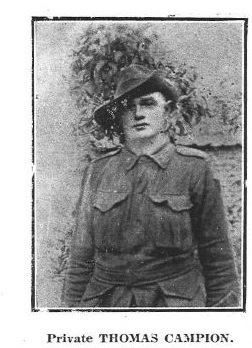Pte
Thomas Campion
Informationen zu Geburt
|
Geburtsjahr: 1886 |
|
Geburtsort: Dalby, Queensland, Australia |
Allgemeine Informationen
|
Beruf: Arbeiter |
Informationen zum Armeedienst
|
Land: Australia |
|
Truppe: Australian Imperial Force |
|
Rang: Private |
|
Dienstnummer: 3803 |
|
Einberufung datum: 06/12/1915 |
|
Einberufung ort: Melbourne, Victoria, Australia |
|
Einheiten: — Australian Infantry, 24th Bn. (Victoria) (Letzte bekannte Einheit) |
Informationen zu Tod
|
Sterbedatum: 09/10/1917 |
|
Todesursache: Im Kampf gefallen |
|
Alter: 31 |
Begräbnisplatz
|
Buttes New British Cemetery, Polygon Wood Grabstelle: VI Reihe: B Grab: 4 |
Auszeichnungen und Orden 2
|
British War Medal Medaille |
|
Victory Medal Medaille |
Punkte von Interesse 2
| #1 | Geburtsort | ||
| #2 | Einberufung ort |
Meine Geschichte
Private Thomas Campion served in the Australian Infantry 24th Battalion, part of the 6th Australian Brigade, of the 2nd Australian Division.
The 2nd Australian Division participated in the Battle of Poelcapelle (9th of October 1917), a stage in the Third Battle of Ypres. The 6th Brigade on the left of the divisional front went forward with the 24th, 22nd, 21st Battalions; the 23rd Battalion was in support. Notwithstanding the exhaustion of the men and the overall lamentable state of the Battalions the Division was ordered to advance towards Daisy Wood.
The artillery barrage which preceded the attack was weak an inaccurate. Consequently as the attacking arties advanced through the boggy ground, they were an easy target for the German snipers and machine-guns. When the 24th Battalion reached Daisy Wood they encountered heavy machine-gun and rifle fire, causing heavy casualties.
Casualties had reduced the units until the attack fell apart into small groups, operating largely on their own initiative. “C” Company in the center merged with “A” Company on the left and established posts in Daisy Wood. The attack came to a standstill and reinforcements of the 28th Battalion had to come over to fill up a gap in the line. Daisy Wood was eventually cleared from German resistance by 2 p.m., but the Battalion was unable to consolidate their gains, due to their small numbers.
German counterattacks and German strongpoints behind Daisy Wood contributed to the dire situation. The positions of the men remained critical throughout the night, but the men held out and were relieved during the night.
Private Thomas Campion was killed in action on the 9th October of 1917. He was initially buried in the field on the Western outskirts of Daisy Wood. The position of his grave is close to the position where “A” and “C” Company merged together and established positions on the utter left flank. Thomas Champion’s remains were exhumed after the war and interred in Buttes New British Cemetery in Polygon Wood.
The 2nd Australian Division participated in the Battle of Poelcapelle (9th of October 1917), a stage in the Third Battle of Ypres. The 6th Brigade on the left of the divisional front went forward with the 24th, 22nd, 21st Battalions; the 23rd Battalion was in support. Notwithstanding the exhaustion of the men and the overall lamentable state of the Battalions the Division was ordered to advance towards Daisy Wood.
The artillery barrage which preceded the attack was weak an inaccurate. Consequently as the attacking arties advanced through the boggy ground, they were an easy target for the German snipers and machine-guns. When the 24th Battalion reached Daisy Wood they encountered heavy machine-gun and rifle fire, causing heavy casualties.
Casualties had reduced the units until the attack fell apart into small groups, operating largely on their own initiative. “C” Company in the center merged with “A” Company on the left and established posts in Daisy Wood. The attack came to a standstill and reinforcements of the 28th Battalion had to come over to fill up a gap in the line. Daisy Wood was eventually cleared from German resistance by 2 p.m., but the Battalion was unable to consolidate their gains, due to their small numbers.
German counterattacks and German strongpoints behind Daisy Wood contributed to the dire situation. The positions of the men remained critical throughout the night, but the men held out and were relieved during the night.
Private Thomas Campion was killed in action on the 9th October of 1917. He was initially buried in the field on the Western outskirts of Daisy Wood. The position of his grave is close to the position where “A” and “C” Company merged together and established positions on the utter left flank. Thomas Champion’s remains were exhumed after the war and interred in Buttes New British Cemetery in Polygon Wood.
Quellen 4
|
24th Australian Infantry Battalion, (Australian War Memorial, Campbell (AWM), AWM4 23/41/25). https://www.awm.gov.au/collection/C1338583 Verwendete Quellen |
|
First Australian Imperial Force Personnel Dossiers, 1914-1920, (National Archives of Australia, Canberra (NAA), B2455, CAMPION T). https://recordsearch.naa.gov.au/SearchNRetrieve/Interface/SearchScreens/NameSearch.aspx. Verwendete Quellen |
|
Harvey W.J., The Red and White Diamond, The Official History of the 24th Battalion, (Uckfield, The Naval & Military Press Ltd, 1920), pg. 190-193. Verwendete Quellen |
|
McCarthy C., The Third Ypres Passchendaele. The Day-by-Day Account, (London, Arms & Armour Press, 1995), pg. 104-106. Verwendete Quellen |
Weitere Informationen 4
|
Commonwealth War Graves Commission Database https://www.cwgc.org/find-records/find-war-dead/casualty-details/480148 |
|
Namenlijst (In Flanders Fields Museum) https://namenlijst.org/publicsearch/#/person/_id=b2129b5c-22a1-443a-bea2-cb3817334545 |
|
Lives of the First World War (Imperial War Museum) https://livesofthefirstworldwar.iwm.org.uk/lifestory/7381380 |
|
The AIF Project (UNSW Canberra) https://aif.adfa.edu.au/showPerson?pid=45419 |
